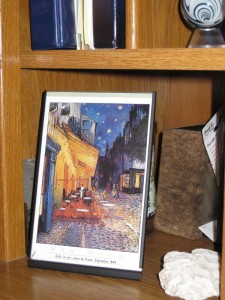Names for God: Part 1 of a Series
I had seen reproductions of Vincent Van Gogh’s paintings long before visiting the d’Orsay in Paris, so I expected that viewing his work would be an encounter with something familiar. It never occurred to me that the originals might hold so much more than those reproductions could show.
It left me completely unprepared for the experience I stumbled into. I was stunned by the vibrancy, riveted by the color. The skies he painted came at me like a physical force.
Maybe it was having recently enjoyed the saturated blues of Mediterranean evenings; maybe it was the mindset of a traveler taking in everything new. I don’t know what opened me to the power of Van Gogh’s canvasses, I only know that I have never experienced color the way I did standing before his paintings. I have never had a sky brought to life and emblazoned on my mind in the same way. For twenty or thirty minutes I couldn’t take in anything else. I was left with an image, or more specifically a color, that overtook everything. That blue.
I bought post cards before leaving the museum—replicas of some of the paintings I had seen. They were pale imitations; the colors were wrong, the depth flattened out, the life drained. The reproductions were just reminders of what I had seen, nothing like standing in front of the real thing. But nonetheless I’m glad for the mementos. Years later, the post cards help me remember the experience of taking in the works of art and being moved by them.
I framed one of the Van Gogh cards and placed it on my desk. I love the image, the color, the conveyance of light, the sense of shelter. It gives me pleasure. I enjoy the framed post card, but it only hints at the power of the original. It doesn’t begin to reveal the divine inspiration Van Gogh conveyed on canvas. And I suspect that even his amazing painting would have fallen short of fully capturing the inspiration he felt, as works of art tend to do.
The words we use to talk about God are a lot like that framed post card. Our names for God are accessible, we can make them part of our lives, they hold meaning and beauty. We fit them into frames on our desks—in readings and hymns, conversation, worship and prayers. But we miss out when we confuse those names with the real thing. We cut ourselves off from the experience of the divine when we think that the little image in the frame is the object of our longing or the expression of our desire.
We need names for God, yet any name for God is a placeholder, a reminder of what will not fit in the frame, what cannot be named.
Is “God” a name that suggests the ineffable for you? What name are you drawn to using?
You might also be interested in:


I had a similar reaction to the work of Van Gogh, only I was at the National Gallery in London when I came upon them quite by accident. We’d gone there in search of William Blake’s work, and as soon we entered this one room (there’s probably another word for the rooms of museums, but I don’t know it) with Van Gogh’s originals lining two walls. I was in tears immediately–before I could even process what I was seeing and experiencing! The depths of his life and soul seemed to be present in those colors even after all these years. Like you, I bought reminders, which I still cherish, but they do seem empty and pale compared to what was real.
Whatever we call God, however we think of such unfathomable mystery, must surely pale in comparison to the numinosity of encountering God.
I’m so glad to hear this beautiful story, Sharon. Thank you. What a powerful experience, even to read about. The capacity of art to reach into us and convey something beyond ordinary knowing is simply amazing. And occasionally, it can feel miraculous. I’m not sure that I want to say art and spirit are the same, but sometimes I don’t know how to tell the difference.